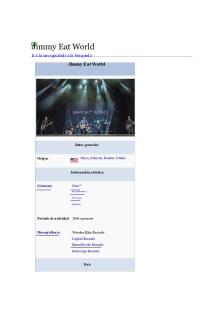Colonial Latin America World History 1010 Dr. Bohanan Lecture Notes (almost word for word) PDF

| Title | Colonial Latin America World History 1010 Dr. Bohanan Lecture Notes (almost word for word) |
|---|---|
| Author | Christine Ivey |
| Course | World History I |
| Institution | Auburn University |
| Pages | 2 |
| File Size | 80.7 KB |
| File Type | |
| Total Downloads | 89 |
| Total Views | 149 |
Summary
Wrote almost exactly every word she said during lecture. Notes are categorized in the same format she makes her power points....
Description
12/26/2021
OneNote
Colonial Latin America Wednesday, November 3, 2021 9:01 AM
I. American Society Food: potatoes, corn, tomatoes, chili peppers, cocoa, cotton tobacco came from the Americas. The Europeans brought coffee from Africa, olives, bananas, onions, sugar cane, citrus fruits. A. Population-When they arrived the Europeans had an immediate negative impact on the populations from disease(small pox/influenza/measles), brutality, labor. Dramatic drops in the populations of Mexico and the Caribbean. The population of the Americas was down by 90%. B. Labor and taxation- The Europeans looked to Africa because the Native Americans population was almost gone. They worked them hard in the mining industry for gold and silver, later used in agriculture. People moved to try and avoid the Spanish and the imposed labor, encomienda system. It was authorized by the government back in Spain. The government gave important leaders like Cortez permission to enforce labor.
• Encomienda
II. Spanish America A. Aristcracy They tried to create a new nobility. They change their mind about the encomienda because they are afraid they won't be able to control them. Haciendas were houses and parts of land carved out by prominent Spanish families. B. Government In Spain there is a council for Latin America, rulers known as Viceroys control the colonies. More layers of bureaucracy form as their sons take political positions. C. Clergy The papacy granted the Spanish money in return for them to convert natives. The jujuist played a prominent role, learned the native language of the native peoples. The church forms in the Americas. The churches were mostly the same architecture but had many native designs. The clergy had a close relationship to government. Clergy sometimes assumed governmental roles. D. Ethnicity and hierarchy The rapid demise of the Amaridian populations played a role. Intermarriage changes social life. Initially troops took advantage of Native American women. Mestizos were mixed European and Native American. Europeans also took advantage of African women slaves. Mulattoes were mixed European and African. By the mid 18thcentury 40% of the population was mixed. Castas were the levels (caste system). Creoles and Peninsulares were all Europeans. Creole means a family that is white that is strictly European but was born in the Americas. Peninsulares were white Spanish, born and educated in Spain but brought over. There was a clash bewteen Creoles and Peninsulares. III. Enlightenment and Bourbon Reforms
• • • • • • •
Haciendas Viceroys Castas Mestizos Mulattoes Creoles Peninsulares
https://tigermailauburn-my.sharepoint.com/personal/cli0007_auburn_edu/_layouts/15/Doc.aspx?sourcedoc={d27782e6-348f-4412-82d0-9e97ebbdd7d2}&action=edit…
1/2
12/26/2021
OneNote
A. Restructuring of government Peninsulareswork towards making the government more efficient to increase taxes. Creoles don't want their family members to lose political positions. Tax rebellions strike up. Independence of Latin America was led by Creoles. B. Colonial reactions
https://tigermailauburn-my.sharepoint.com/personal/cli0007_auburn_edu/_layouts/15/Doc.aspx?sourcedoc={d27782e6-348f-4412-82d0-9e97ebbdd7d2}&action=edit…
2/2...
Similar Free PDFs

History 1010 lecture 12
- 6 Pages

Jimmy Eat World - Eat word
- 16 Pages

Examen word - guia word
- 12 Pages

Latin America chapter 4 notes
- 8 Pages

Word - Samenvatting Word
- 2 Pages

WORD
- 21 Pages

History OF Cricket 100 WORD
- 2 Pages

Apuntes America colonial
- 50 Pages

Colonial America- Reading Guide
- 15 Pages

A - Latin America
- 12 Pages
Popular Institutions
- Tinajero National High School - Annex
- Politeknik Caltex Riau
- Yokohama City University
- SGT University
- University of Al-Qadisiyah
- Divine Word College of Vigan
- Techniek College Rotterdam
- Universidade de Santiago
- Universiti Teknologi MARA Cawangan Johor Kampus Pasir Gudang
- Poltekkes Kemenkes Yogyakarta
- Baguio City National High School
- Colegio san marcos
- preparatoria uno
- Centro de Bachillerato Tecnológico Industrial y de Servicios No. 107
- Dalian Maritime University
- Quang Trung Secondary School
- Colegio Tecnológico en Informática
- Corporación Regional de Educación Superior
- Grupo CEDVA
- Dar Al Uloom University
- Centro de Estudios Preuniversitarios de la Universidad Nacional de Ingeniería
- 上智大学
- Aakash International School, Nuna Majara
- San Felipe Neri Catholic School
- Kang Chiao International School - New Taipei City
- Misamis Occidental National High School
- Institución Educativa Escuela Normal Juan Ladrilleros
- Kolehiyo ng Pantukan
- Batanes State College
- Instituto Continental
- Sekolah Menengah Kejuruan Kesehatan Kaltara (Tarakan)
- Colegio de La Inmaculada Concepcion - Cebu





